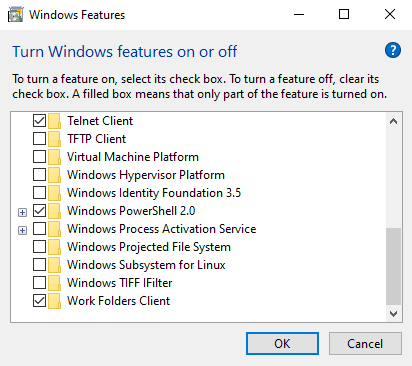
- HOW TO USE TELNET TO SEE IF PORT IS OPEN INSTALL
- HOW TO USE TELNET TO SEE IF PORT IS OPEN PASSWORD
- HOW TO USE TELNET TO SEE IF PORT IS OPEN WINDOWS
If the port is open, you will see an output like the following: Check Linux Port Using Telnet This feature is useful in figuring out any vulnerabilities present on your system.įor instance, we can check if the above discussed remote system has port 80 open by executing the following command: $ telnet 192.168.207.130 80 Testing Open Ports on Linux via TelnetĪnother interesting feature Telnet offers its users is its ability to detect an open or closed port on a targeted remote system via its IP address. Once granted access, the interface should change to something like the following: Telnet Remote Linux Loginįrom here, we can perform normal OS operations if needed.
HOW TO USE TELNET TO SEE IF PORT IS OPEN PASSWORD
$ telnet 192.168.207.130Īn acceptable user login input will be followed by a password request which when we key in should give us managerial access to the remote Linux system. We can now attempt to make a Telnet connection to a targeted/remote Linux machine. $ sudo firewall-cmd -permanent -zone=public -add-port=23/tcp If you are using or have a firewall enabled on your remote/targeted Linux machine, you will need to allow traffic through port 23 since Telnet uses it for its network communication. The above IP address belongs to the targeted machine. The implementation of the above syntax rule will look like the following: $ telnet 192.168.207.130 On the Telnet-powered server machine, we will adhere to the following syntax rule: $ telnet

HOW TO USE TELNET TO SEE IF PORT IS OPEN INSTALL
$ sudo apt install telnetd -yĪlso, check on the status of Telnet to make sure it is running on the remote machine too. $ ifconfigĪlso, the targeted remote Linux machine should have Telnet installed on it as per the suggested installation commands discussed above. To perform an unencrypted connection to remote host systems via Telnet, we first need to identify the IP address of the machine we are targeting. $ sudo systemctl status inetdĬheck Telnet in Linux Testing Remote Linux Connections via Telnet $ sudo zypper install telnetd Ĭheck on its status to make sure it is up and running. $ sudo emerge -a net-misc/netkit-telnetd

Since Telnet is unencrypted, its recommended usage is for testing purposes only and in user-defined networks. This article will walk us through the installation and usage of this ancient server administration protocol. It is worth noting that Telnet utilizes port 23 for its remote TCP connections. With Telnet, you not only get to establish successful remote connections but also troubleshoot and test the system services that define the remote computing environment.įor instance, we could check if a particular port is active/open/listening on the targeted remote system. Telnet achieves the same functionality through TCP/IP protocol. That's written for SQL Server 2000, but I don't imagine this aspect has changed much, if at all.Remote access to other operating system environments on an active network is not just a thing of the SSH ( Secure Shell) protocol. This article says you can go further and try connecting to the IPC$ share: net use \\servername\IPC$ If SQL Server is using Named Pipes, then I believe if you're able to access shares on the machine, you have adequate network connectivity.
HOW TO USE TELNET TO SEE IF PORT IS OPEN WINDOWS
Otherwise, dig through the Windows event log or the SQL Server error log for a message indicating which port is in use by the instance. If it's using dynamic ports, then as long as you don't have multiple instances on the server, netstat -abnis probably the simplest way to find what it's using.

Check SQL Server configuration manager to see if it's a specific port, or dynamic ports. If it's using a different port, or dynamic ports (common with a named instance), then you'll need to determine which port it's currently listening on. That will probably be appropriate in most cases.

By default, that's port 1433, so this should work: telnet servername 1433 If the server is using TCP/IP, then the simple way is to just telnet to the SQL Server port and see if it connects.


 0 kommentar(er)
0 kommentar(er)
